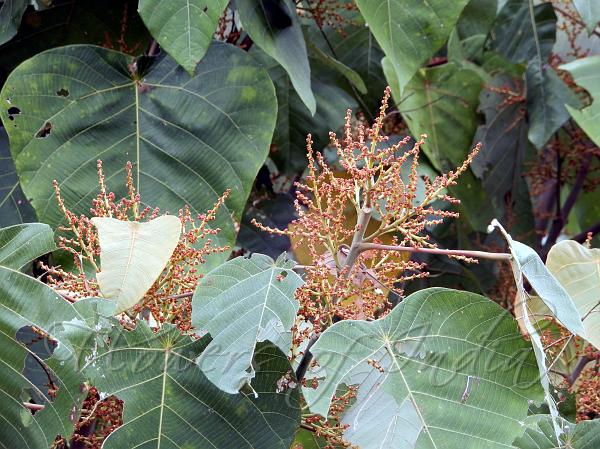|
| Indian Macaranga |
|

|

| File size | 1020802 |
| Original date | 3/31/21 1:16 PM |
| Resolution | 3648 x 2736 |
| Flash | Flash did not fire, auto |
| Focal length | 40.1mm |
| Exposure time | 1/60s |
| Aperture | 5.6 |
| Focus Distance | |
| Metering Mode | Multi-segment |
| Camera make | NIKON |
| Camera model | COOLPIX A900 |
| Sensor type |
|
|
|
|
Photo: |
Botanical name: Macaranga indica Family: Euphorbiaceae (Castor family)
Synonyms: Macaranga adenantha, Trevia hernandiifolia, Tanarius indicus
Synonyms: Macaranga adenantha, Trevia hernandiifolia, Tanarius indicus
Indian Macaranga is a tree 10-25 m tall. Branchlets
are yellowish brown velvet-hairy when young; branches stout, hairless,
slightly glaucous. Stipules are broadly ovate, tapering, 1.5-2 × about
1 cm, velvet-hairy, recurved, falling off. Leaf-stalk is 11-14 cm; leaf
blade ovate-round, 14-25 × 13-23 cm, thinly leathery, below
velvet-hairy and glandular-scaly, above hairless or hairy along veins,
base rounded and stalk connected away from the edge. Leaves nearly
always with a few prominent glands on main veins near the point where
the stalk is connected. Tip is tapering; palmate veins 9. Male
inflorescences are branched, 10-15 cm, branchlets zigzag; bracts
linear-spoon-shaped, 4-7 mm, with 1-3 elliptic glands, or bracts
minute, triangular. Male flowers many per bract. Female inflorescences
are branched, 5-6 cm; bracts triangular, about 1 mm, velvet-hairy.
Female flowers are solitary; sepals 4, about 1.5 mm, hairy, persistent.
Capsule is spherical, about 4 mm in diameter, sparsely glandular-scaly,
stalk 3-4 mm, velvet-hairy. seeds smooth, black. Indian Macaranga is
found in Valleys, riverbanks, primary or secondary forests, at
altitudes of 300-1900 m, in NE India, Bhutan, India, Indonesia, Laos,
Malaysia, Myanmar, Nepal, Sri Lanka, Thailand, Vietnam. Flowering:
August-October.
| Identification credit: Pradip Krishen, Tabish | Photographed in Mawlynnong, Meghalaya. |
• Is this flower misidentified? If yes,